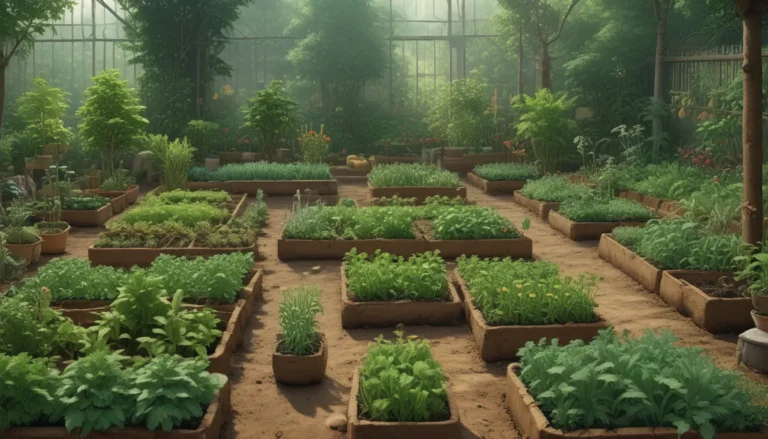The Ultimate Guide to Planting and Growing Lemon Thyme

Unlocking the Secret of Lemon Thyme
Lemon thyme, with its vibrant chartreuse foliage and citrus aroma, is a must-have herb in any garden. Not only does it elevate the flavors of fish and poultry, but it also attracts beneficial insects and pollinators, making it a valuable addition to your garden.
In this comprehensive guide, we will explore everything you need to know about growing and caring for lemon thyme. From cultivation and history to harvesting and cooking tips, you will discover the secrets of this versatile and aromatic herb.
Cultivation and History of Lemon Thyme
Lemon thyme, known scientifically as Thymus citriodorus, is a perennial herb that thrives in USDA Hardiness Zones 5 to 9. Despite its name, recent DNA studies have confirmed that lemon thyme is a distinct plant species within the Thymus genus.
Cherished by chefs and herbal medicine makers alike, lemon thyme combines the sharp scents of citrus with the earthy essence of thyme. Its leaves are prized for their culinary applications in soups, salads, sautees, and meat dishes, as well as their aromatic qualities in perfumes and skincare products.
Lemon Thyme Plant Propagation Methods
From Seed
While thyme seeds can be slow to germinate, you can start lemon thyme from seed by sowing them indoors in early spring or directly outdoors after the last frost. Keep the soil consistently moist but not waterlogged to ensure successful germination.
From Cuttings
Propagation from stem cuttings is another popular method for starting lemon thyme plants. Simply take a three- to four-inch cutting from an established plant, remove the lower leaves, and plant it in a well-draining potting medium. With proper care, the cutting will develop roots in four to six weeks.
From Divisions
For mature lemon thyme plants, division propagation is an effective way to expand your herb garden. Simply divide the root ball into sections and replant them in new locations. Water the divisions regularly until they establish themselves in their new environment.
Planting and Growing Lemon Thyme
When planting lemon thyme, choose a sunny location with well-draining soil. Water your plants deeply and consistently to help them establish strong roots. While lemon thyme is relatively low maintenance, regular pruning and deadheading can encourage new growth and maintain the plant’s shape.
Growing Tips for Healthy Lemon Thyme Plants
- Plant in well-draining soil.
- Provide a full sun location.
- Allow the soil to dry out to an inch or two deep between waterings.
Lemon Thyme Cultivars to Explore
In addition to the species plant, there are several cultivars of lemon thyme available to home gardeners. Variations in foliage, growth habits, and aroma distinguish these cultivars from each other. From ‘Aureus’ with its mounding form to ‘Golden Queen’ with pink blooms, each cultivar offers a unique twist on the classic lemon thyme flavor.
Managing Pests and Disease in Lemon Thyme Plants
While lemon thyme is generally resistant to pests and diseases, occasional issues with aphids or spider mites may arise. Proper plant care, including well-draining soil and adequate air circulation, can help prevent fungal diseases like botrytis rot and root rot.
Insect Control Tips
- Monitor for aphids and spider mites on the undersides of leaves.
- Use a strong spray of water or a homemade insecticidal soap to control aphid infestations.
- Remove any infected areas of the plant to prevent the spread of disease.
Disease Prevention Measures
- Plant lemon thyme in well-draining soil to prevent root rot.
- Avoid overwatering to reduce the risk of fungal diseases.
- Prune and stake plants to improve air circulation and reduce humidity.
Harvesting and Preserving Lemon Thyme
Harvest lemon thyme by snipping a few inches down the stem just above a node of new growth. For optimal flavor, harvest the leaves just before the flowers open. To preserve your harvest, consider drying the leaves using methods such as hang drying, oven drying, or dehydrating.
Cooking Tips and Recipe Ideas
Lemon thyme adds a delightful zing to a variety of dishes, including sauces, salads, soups, seafood, and poultry. Whether used fresh or dried, lemon thyme enhances the natural flavors of these dishes with its citrusy aroma and herbal taste. Experiment with incorporating lemon thyme into your favorite recipes for a burst of fresh flavor.
Quick Reference Growing Guide for Lemon Thyme
- Plant Type: Perennial woody herb
- Native to: Mediterranean
- Hardiness (USDA Zone): 5-9
- Exposure: Full to part sun
- Height: 6-12 inches
- Spread: 12-18 inches
- Water Needs: Low
- Common Pests and Disease: Aphids, spider mites; Root rot
- Companion Planting: Brassicas, nightshades
Embrace Lemon Thyme in Your Garden
As you embark on your journey of growing lemon thyme, remember to savor the joy of connecting with nature and cultivating fresh herbs in your garden. Whether you use lemon thyme for cooking, aromatherapy, or simply to admire its beauty, this versatile herb has much to offer.
Share your experiences and questions about lemon thyme in the comments below, and let the fragrant aroma of this herbal queen inspire your gardening adventures. Happy growing!
For more herb-growing guides and tips, don’t miss our other informative articles:
- How to Grow and Care for Common Thyme
- How to Grow Creeping Thyme as an Aromatic Ground Cover
- How to Start Your Own Herb Garden
All rights reserved. Originally published May 1st, 2021. Last updated March 16th, 2023.





